Newspapers Really Do Spin: A Case Study of the Sycamore True Republican
Origins and Influences
In 1857, Campbell Waite began publishing the Sycamore True Republican (De Kalb County, Illinois) as an organ for the newly formed Republican Party. Waite was particularly interested in promoting the anti-slavery portion of the Republican platform.1 Waite selected Sycamore as the location for his anti-slavery newspaper only after he had decided to publish one—in fact, Waite wasn't even living in De Kalb County, and never had lived there, when he reached this decision. He started making plans for the new enterprise while living in Peoria, just months after the Republican Party held its first national convention.2 In the presidential election following that convention, Illinoisans almost evenly split their votes between Republican and Democratic candidates (40% to 44%). Voters in De Kalb County, however, went overwhelmingly for the Republican (83% to 14%). In fact, only two other Illinois counties—Boone and Winnebago—voted more overwhelmingly Republican than De Kalb,3 and all three were geographically contiguous, making the region a Republican stronghold, and De Kalb County an ideal location for a Republican newspaper.4 Waite chose Sycamore, the seat of government for De Kalb County, as the home for his True Republican, and within a year he was publishing what became, more than a century later, De Kalb County's oldest newspaper.
Waite published the first issue of the True Republican on September 22, 1857.5 In its early years, the paper was stridently partisan, issuing the hottest kind of editorials
,6 reflecting the political turbulence of the era. So great was the paper's zeal for the Republican cause that, in 1858, it issued Lincoln’s famous "House Divided" speech as a separate pamphlet, and made history as the first publisher to do so.7 The paper's passion for abolition was reflected in its (somewhat unwieldy) motto: The union of all for the preservation of the liberty of all, not the union of many for the destruction of the liberty of the few
. Both Waite and his financial backers were influenced by abolitionist newspapers like the Western Citizen in Chicago.8 Although the True Republican frequently changed ownership, all the early publishers were fervently opposed to slavery. Ownership of the newspaper finally settled into the hands of Henry L. Boies, and remained in his family for decades.9
The paper's name, True Republican, would not have seemed as bold a choice then as perhaps it does today. "True Republican" was a popular title for nineteenth century newspapers, and a popular pseudonym for newspaper correspondents (as was "True Democrat"). For most of the nineteenth century, the words "Democrat" and "Republican" did not denominate competing ideologies, and the nation's party system was in an almost constant state of flux, at times seeming hardly to exist at all.10 The two biggest periods for the launching of "True Republican" newspapers were 1800 to 1810, and then 1860 to 1880. During the first wave, "Republican" probably referenced the concept of republicanism in the abstract, as the nation debated among itself the meaning of "true" republicanism.11 The newspapers of the second wave, however, were almost certainly aligning themselves with the recently formed Republican Party. The Sycamore True Republican, obviously, came from this second wave. Waite likely also intended the "true" in True Republican to distinguish his paper from the Sycamore Republican Sentinel, which was actually a Democratic paper, its title being an artifact of the terminological ambiguity so common in antebellum America. Until the formation of the anti-slavery Republican Party in the late 1850s, the party of Andrew Jackson variously styled itself "Democratic", "Republican", and, as is most commonly taught in schools today, "Democratic Republican".12 The Sycamore Republican Sentinel was this earlier, Jacksonian type of "Republican", and Waite surely wished to emphasize that his newspaper, not the Republican Sentinel, represented the "true" Republican Party.
The paper seems to have been heavily influenced by the Chicago Tribune, the great radical Republican organ of the West
.13 During the Civil War, Waite moonlighted as a war reporter for the Tribune,14 and the True Republican reliably published, with endorsement, the Tribune's annual prospectus. The very look of the True Republican was probably even influenced by the Tribune. In 1855,15 the Tribune changed from a blackletter title to roman. Not surprisingly, when the True Republican debuted just two years later, its nameplate resembled the Tribune's, with full-face Modern roman capitals (either a Didot, Bodoni, or some derivation thereof), abrupt contrast between thick and thin strokes, unbracketed hairlines for the horizontal serifs, and vertical serifs so heavily bracketed they almost become wedge-like triangles (this style is often called "Fat Face").


The publisher name was printed between transverse, double fine rules, followed by numbering, date, and place of publication. A bold, transverse rule marked the end of the nameplate. By 1860, the Tribune had reverted back to white-lined blackletter for its titling, and the True Republican followed suit shortly thereafter, at first with a rather fussy, elaborately filigreed blackletter, before eventually settling on a stouter version, similar to the Tribune's.
Growth and Change
Like most country newspapers, the True Republican began as a weekly.16 The advent of readyprint in 1865 enabled many country editors to expand from weekly to semiweekly publication, often at little or no additional cost.17 Readyprint was a subscription service through which newspaper publishers purchased the paper sheets they needed for their presses from a news syndicate instead of a paper company. These sheets came preprinted on one side with national news, news features, literary works, essays, and advertisements.18 Publishers who used readyprint had to accept the fact that their second and third pages would be identical to hundreds of other newspapers across the country. Because country newspapers were the principal consumers of readyprint, and because rural communities were relatively isolated, this fact was not well known, and many publishers passed readyprint pages off as original content. For comparison, here are the second and third pages of two country newspapers: the Sycamore True Republican, and the McConnelsville, Ohio Conservative: the pages are identical, and there would have been dozens if not hundreds of other country newspapers that also published the same pages that week.
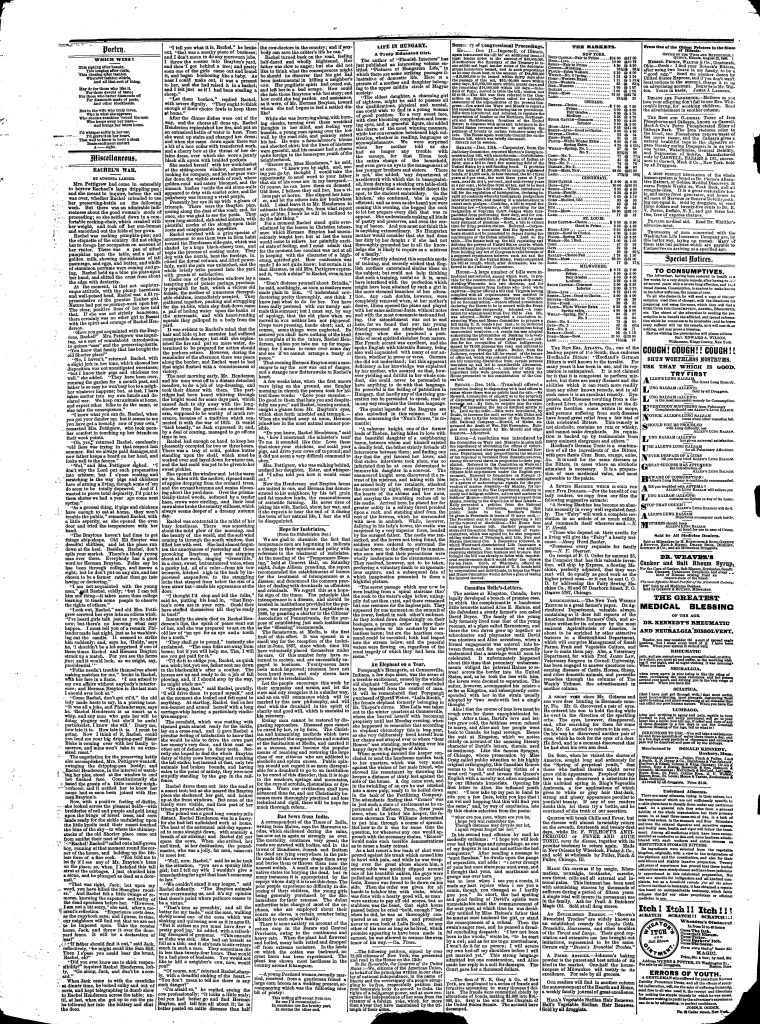
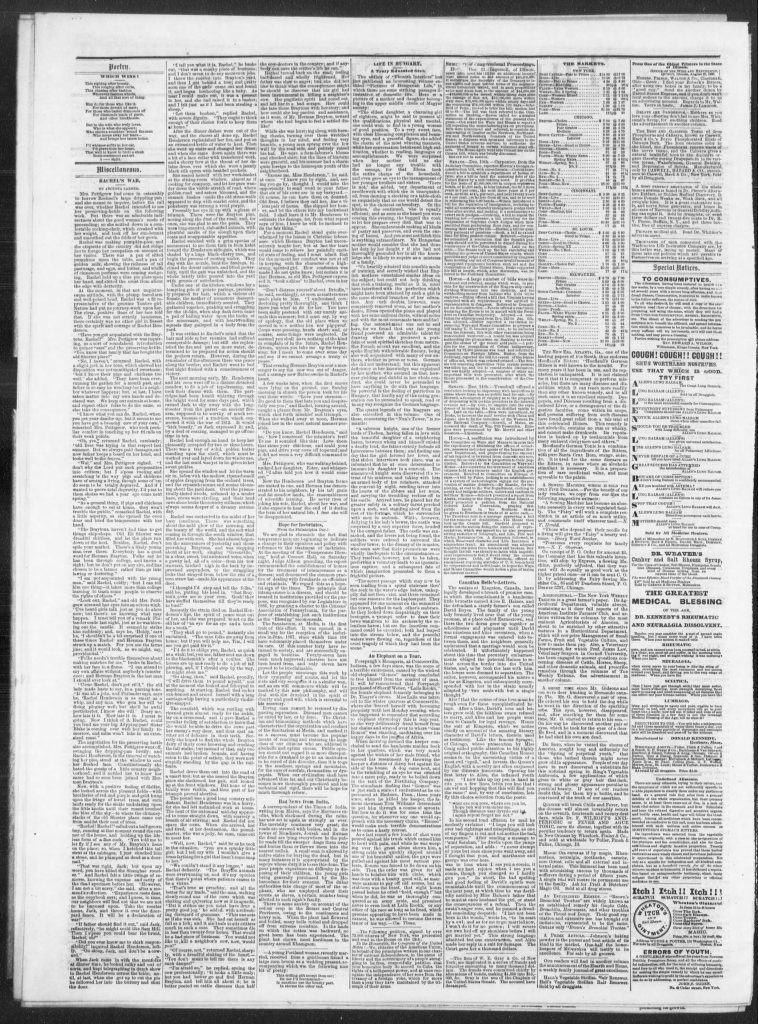
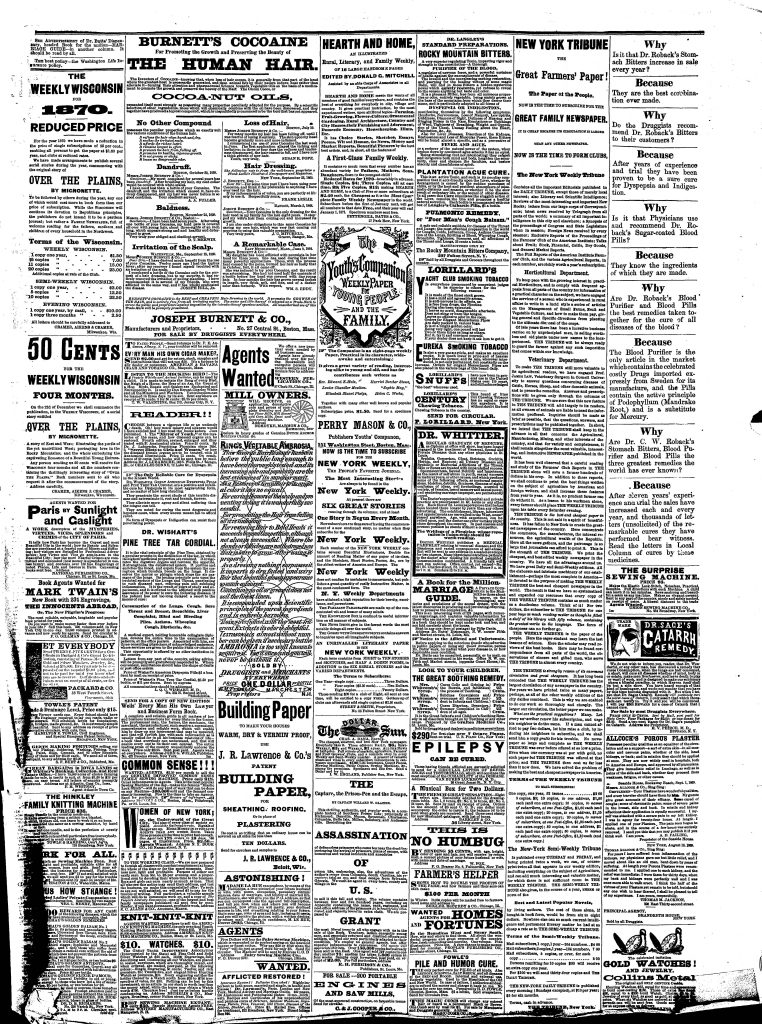
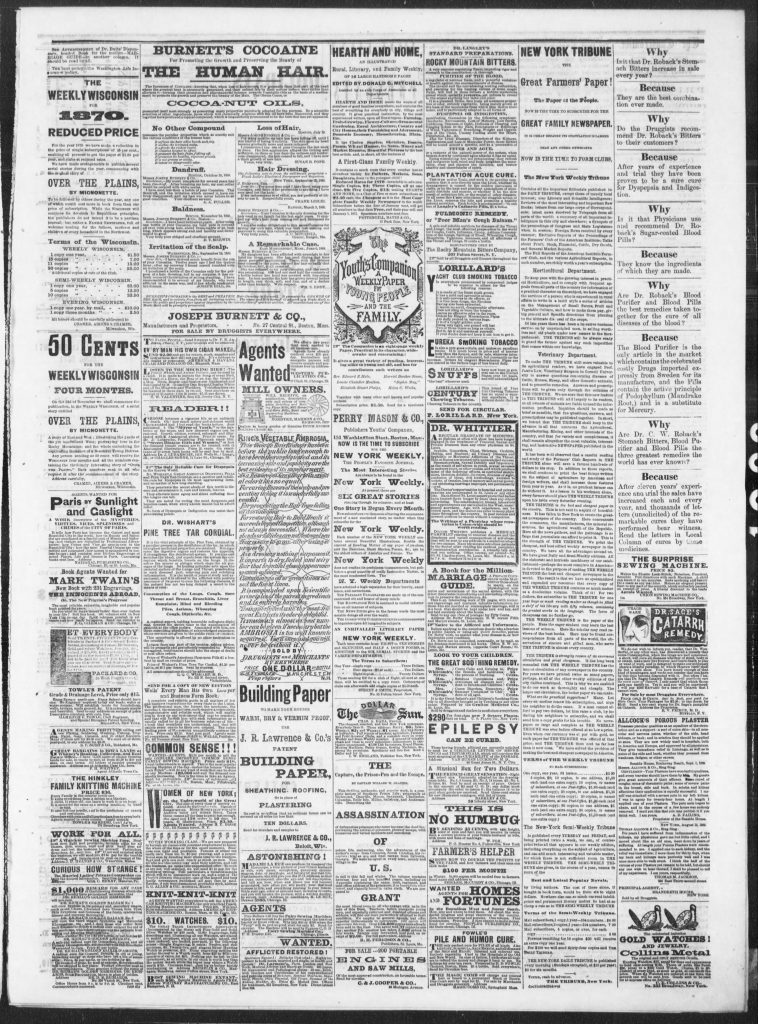
The reverse side of each sheet, however, was blank, and on this blank side the publisher printed his or her own news and advertisements—usually local news and editorials. Readyprint essentially cut the publisher's workload in half, and made it possible for small newspaper publishers to compete with the heavily capitalized newspapers coming out of big cities.19 The largest readyprint syndicate was the Western Newspaper Union (WNU) in Chicago, which is almost certainly where Boies obtained his readyprint. The WNU would have sent a supply of half-printed sheets twice a week, cash on delivery, by the Chicago and Northwestern Railway. Sycamore was served by a connecting line,20 as seen below.

Boies was an early adopter of this innovative business model, and thanks to it he was able to increase publication frequency from weekly to semiweekly by the end of 1869.
The True Republican began as a large, four page, broadsheet with a seven column make-up. It expanded to eight columns sometime between April, 1890, and January, 1891 (the intervening issues are missing). On December 14, 1895, the paper changed from a four page, eight-column journal, to an eight page, six-column journal, primarily to create a roomier layout for advertisements.22
Competition and End
By the 1940s, Sycamore was still being served by two Republican newspapers: the Sycamore Tribune and the True Republican. Although many small towns continued to support two newspapers well into the twentieth century, it was more typical for each newspaper to represent an opposing political party, Democrat or Republican. The situation in Sycamore, where both papers were Republican, was less common. In 1943, the publisher of the Tribune purchased the True Republican, with Frank Dean of the Tribune continuing on as editor of both papers.23 At the time of the merger, Dean expressed a desire to publish a new paper under a less political, more generic name, like "Sycamore Tribune". Such a name, he argued, would better reflect the political diversity of the paper's readership, as well as professional trends away from partisan journalism. In the end, however, Dean decided to continue publishing the True Republican under its original name, in deference to the paper's venerable status as the oldest newspaper in the county.24 He changed the paper's publication frequency, however, from semiweekly back to weekly.
Although the True Republican was the most prestigious newspaper published from the county seat, it was ultimately eclipsed by its historic rival, the Democratic De Kalb Daily Chronicle, published in the nearby town of De Kalb. Over the decades, the two papers battled for readers and influence,25 but demographic shifts within the county and the region finally favored a daily newspaper published at De Kalb, which had become the county's largest town as early as 1900, driven in part by its location on the Chicago and Northwestern main line, and the creation of a normal school there in 1895. Like the True Republican, the Chronicle covered Sycamore and the rest of the county too, but it offered readers the news every day of the week (except Sunday). In 1908, the Chronicle secured a much-coveted Associated Press (AP) franchise, giving it the exclusive right to print AP dispatches in De Kalb County, the same market served by the True Republican. The True Republican, in contrast, was still relying on readyprint to round out its coverage with a smattering of national and international news. One of readyprint's inherent weaknesses, however, became glaringly obvious when contrasted with the AP stories that had suddenly become available to De Kalb County readers: readyprint specialized in so-called evergreen matter
,26 a publishing term to describe news content with a lengthy shelf life. Given the logistics of the readyprint business model, it simply could not supply its customers with the latest news. So, for example, while the September 9, 1908 issue of the Chronicle carried same-day reports of breaking news from across the country, delivered with lightning speed over the telegraph wires, the True Republican's state, national, and international news was already four days old, most of it human interest material like profiles of prominent men and women, or reports on slow moving murder trials abroad. The True Republican continued to provide superior coverage of local news from the county seat, and the Chronicle would frequently print news first reported by its rival. This practice was, however, part of a reciprocal news-sharing agreement between the two papers. As shown below, the first article was the original version printed in the True Republican, without a credit line, while the story beneath it was printed in the Chronicle, and credited to the True Republican
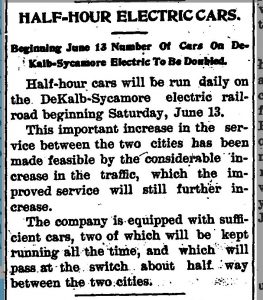
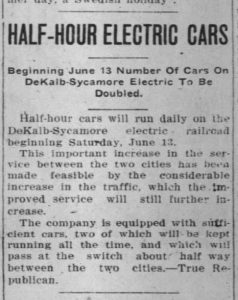
Note the difference between readyprint, where the articles, if not the entire pages, are typographically identical, and exchanged news, like the above, where each newspaper reset the story with its own type.
By the 1920s, The Chronicle began aggressively marketing its carrier service in Sycamore, offering Sycamore residents the tantalizing prospect of a newspaper delivered directly to their homes, six days a week. Not surprisingly, the news sharing between the two papers ceased at this time as well.
In 1969, the Scripps League purchased the Daily Chronicle,27 absorbing it into a formidable newspaper chain, with access to vast financial resources, as well as feature and editorial content from Scripps's NEA (Newspaper Enterprise Association) and news reports from the Scripps owned UPI (United Press International).
Less than a year later, in a last ditch effort to compete with the Scripps-powered Chronicle, the True Republican merged with two other De Kalb County weeklies to form a daily newspaper called the De Kalb County Journal. The new venture lasted a little over a year before folding.
Notes
1. See 1856 platform of the Republican Party in: Donald Bruce Johnson, ed., National Party Platforms, Rev. ed, vol. 1 (Urbana: University of Illinois Press, 1978), 27–28.
2. Nancy M. Beasley, The Underground Railroad in DeKalb County, Illinois (Jefferson, North Carolina: McFarland & Company, Inc., Publishers, 2013), 150. Waite moved to Sycamore in 1856.
3. Michael J. Dubin, United States Presidential Elections, 1788-1860: The Official Results by County and State (Jefferson, North Carolina: McFarland & Co, 2002), 138–40.
4. Beasley, The Underground Railroad in DeKalb County, 150 According to Beasley, the size of the abolitionist movement in De Kalb County was one of the reasons why Waite chose Sycamore as the location for his newspaper. He had previously lived in Peoria.
5. "Newspaper in Lengthy Life," De Kalb Daily Chronicle, January 18, 1941, 2; Frank William Scott, Newspapers and Periodicals of Illinois, 1814-1879, Rev. and enl. ed, Collections of the Illinois State Historical Library 6 (Springfield, Ill: Illinois State Historical Library, 1910), 331. There’s some dispute over who actually "founded" the True Republican, with Franklin Scott giving the honors to C.W. Waite, while a Daily Chronicle retrospective names C.M. Brown, J.H. Beveridge, and D.B. James.
6. "Campbell W. Waite," The True Republican, February 17, 1904, 1; A Republican journal in Boone County, in a favorable review of the True Republican's first issue, described it as strongly Republican in sentiment
: "New Paper in DeKalb County," Belvidere Standard, October 6, 1857, 2.
7. Paul M. Angle, "Four Lincoln Firsts," The Papers of the Bibliographical Society of America 36, no. 1 (1942): 6.
8. Beasley, The Underground Railroad in DeKalb County, 150–60.
9. The Biographical Record of De Kalb County, Illinois (Chicago, Ill.: S.J. Clarke, 1898), 31–33; Portrait and Biographical Album of De Kalb County, Illinois (Chicago, Ill.: Chapman Bros, 1885), 795.
10. The so-called "Era of Good Feeling". See: "Era of Good Feeling," Columbian Centinel, July 12, 1817, 2.
11. The heyday for beginning newspapers titled "True Democrat" was, interestingly, 1840 to 1860. For more on contemporary meanings of these terms, see: Michael Lienesch, "Jefferson and the American Democratic Experience: The Origins of the Partisan Press, Popular Political Parties, and Public Opinion," in Jeffersonian Legacies (Charlottesville, Va.: University Press of Virginia, 1993), 316.
12. This would be the period of the Second Party System, which began with the transformation of the National Republican Party into the Whig Party. See Daniel Walker Howe, What Hath God Wrought: The Transformation of America, 1815-1848, Oxford History of the United States (Oxford: Oxford University Press, 2007), 390.
13. "[We Publish This Week]," Sycamore True Republican, December 15, 1869, 1. For decades, Boies offered joint subscriptions to the True Republican and the Chicago Tribune at special "club rates". This was not a period during which newspapers cared whether they seemed partisan. Quite the contrary: partisanship was half the point.
14. "Campbell W. Waite," Chicago Sunday Tribune, February 21, 1904, 4.
15. June 23, 1855: "Publisher’s Notice," Chicago Daily Tribune, June 23, 1855, 2.
16. Frank Luther Mott, American Journalism : A History, 1690-1960, 3d ed. (New York: Macmillan, 1962), 396.
17. Eugene C. Harter, Boilerplating America: The Hidden Newspaper, ed. Dorothy Harter (Lanham, Md: University Press of America, 1991).
18. Many of the pre-printed advertisements were, notoriously, for patent medicines, which earned this service the derisive nickname "patent insides". Gerald J. Baldasty, The Commercialization of News in the Nineteenth Century (Madison, Wis: University of Wisconsin Press, 1992), 93.
19. Millard Van Marter Atwood, The Country Newspaper, The National Social Science Series (Chicago: A.C. McClurg & Co, 1923), 20.
20. A small branch line operated by the Sycamore and Cortland Railway connected Sycamore to the Chicago and Northwestern Railroad. See: Edward Vernon, Travelers' Official Guide of the Railways and Steam Navigation Lines for the United States and Canada (Philadelphia, Pa.: [s.n.], 1870), [108]; C. R. McLagan, Nostalgia and Glee in Sycamore, Illinois (Sycamore, Ill., D. C. Lithographers, 1960), 90–91; and Debbe Nelson, "Rumble of Tracks May Vanish," Daily Chronicle, February 27, 1976, 13.
21. Land Department of the Chicago and Northwestern Railway, "Map Showing the Location of the Chicago and Northwestern Railway with Its Branches and Connections through Illinois, Iowa, Nebraska, Wisconsin, Minnesota, Michigan," map (Chicago, Ill.: Edward Mendel, 1869).
22. "[We Publish This Week]," 4.
23. Harriet Wilson Davy, From Oxen to Jets: A History of De Kalb County, 1835-1963 (Dixon, Ill.: De Kalb County Board of Supervisors, 1963), 115.
24. "Papers Here Consolidate: Frank Dean Heads New Corporation Which Will Take Over Republican," De Kalb Daily Chronicle, November 27, 1943, 2.
25. In a retrospective, the Chronicle's editor facetiously referred to the True Republican as its archenemy
. John Kelleher, "Chronicle Turns 125," Daily Chronicle, March 8, 2004, 44; The Chronicle complained bitterly about what it perceived to be corrupt political patronage in the awarding of legal printing contracts "Papers Here Consolidate: Frank Dean Heads New Corporation Which Will Take Over Republican," 1; For more on the politics and economics of legal advertising, see: W.W. Loomis, "Legal Printing: Bone of Contention," United States Publisher 8, no. 1 (January 1930): 3–64.
26. Elmo Scott Watson, A History of Newspaper Syndicates in the United States, 1865-1935 (Chicago, Ill, 1936), 13.
27. De Kalb County Historical-Genealogical Society, ed., Acres of Change: A History of De Kalb County, Illinois, 1963-2012 (Evansville, Indiana: M.T. Publishing Company, Inc, 2013), 156.
Bibliography
Newspapers
Belvidere (IL) Standard
Boston Columbian Centinel
Chicago Tribune
Chicago Western Citizen
De Kalb (IL) Daily Chronicle
McConnelsville (OH) Conservative
Sycamore (IL) Republican Sentinel
Sycamore (IL) Tribune
Sycamore (IL) True Republican
Books and Journal Articles
Angle, Paul M. "Four Lincoln Firsts." The Papers of the Bibliographical Society of America 36, no. 1 (1942): 1–17.
Atwood, Millard Van Marter. The Country Newspaper. The National Social Science Series. Chicago: A.C. McClurg & Co, 1923.
Baldasty, Gerald J. The Commercialization of News in the Nineteenth Century. Madison, Wis: University of Wisconsin Press, 1992.
Beasley, Nancy M. The Underground Railroad in DeKalb County, Illinois. Jefferson, North Carolina: McFarland & Company, Inc., Publishers, 2013.
Davy, Harriet Wilson. From Oxen to Jets: A History of De Kalb County, 1835-1963. Dixon, Ill.: De Kalb County Board of Supervisors, 1963.
De Kalb County Historical-Genealogical Society, ed. Acres of Change: A History of De Kalb County, Illinois, 1963-2012. Evansville, Indiana: M.T. Publishing Company, Inc, 2013.
Dubin, Michael J. United States Presidential Elections, 1788-1860: The Official Results by County and State. Jefferson, North Carolina: McFarland & Co, 2002.
Harter, Eugene C. Boilerplating America: The Hidden Newspaper. Edited by Dorothy Harter. Lanham, Md: University Press of America, 1991.
Howe, Daniel Walker. What Hath God Wrought: The Transformation of America, 1815-1848. Oxford History of the United States. Oxford: Oxford University Press, 2007.
Johnson, Donald Bruce, ed. National Party Platforms. Rev. ed. Vol. 1. 2 vols. Urbana: University of Illinois Press, 1978.
Lienesch, Michael. "Jefferson and the American Democratic Experience: The Origins of the Partisan Press, Popular Political Parties, and Public Opinion." In Jeffersonian Legacies, 316–39. Charlottesville, Va.: University Press of Virginia, 1993.
Loomis, W.W. "Legal Printing: Bone of Contention." United States Publisher 8, no. 1 (January 1930): 3–64.
McLagan, C. R. Nostalgia and Glee in Sycamore, Illinois. Sycamore, Ill., D. C. Lithographers, 1960.
Mott, Frank Luther. American Journalism : A History, 1690-1960. 3d ed. New York: Macmillan, 1962.
Portrait and Biographical Album of De Kalb County, Illinois. Chicago, Ill.: Chapman Bros, 1885.
Scott, Frank William. Newspapers and Periodicals of Illinois, 1814-1879. Rev. and enl. ed. 1 vols. Collections of the Illinois State Historical Library 6. Springfield, Ill: Illinois State Historical Library, 1910.
The Biographical Record of De Kalb County, Illinois. Chicago, Ill.: S.J. Clarke, 1898.
Vernon, Edward. Travelers' Official Guide of the Railways and Steam Navigation Lines for the United States and Canada. Philadelphia, Pa.: [s.n.], 1870.
Watson, Elmo Scott. A History of Newspaper Syndicates in the United States, 1865-1935. Chicago, Ill, 1936.